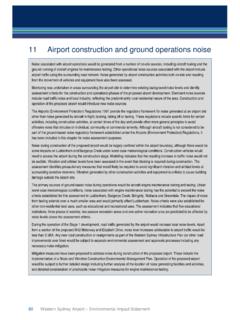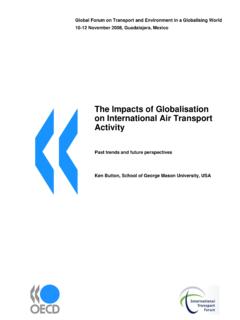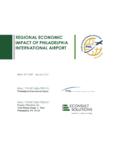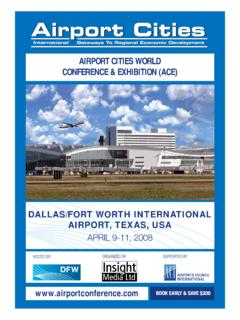Transcription of Requirements for design and construction
1 Requirements for design and construction The Notice of Intention includes directions on how Western Sydney airport should be developed. The Functional Specification sets out the Australian Government's Requirements for the design and construction of the airport informed by the airport Plan, while still allowing the developer to adopt innovative design . The airport will be designed to cater for the passengers of the future and be prepared for five years of forward demand. It will be a 21st-century airport , equipped for the latest technological advancements. A full-service airport The Functional Specification requires the airport to be a full-service airport right from the beginning of operations. This means that it can accommodate leisure carriers, such as Jetstar, and full-service carriers, such as Qantas and Virgin Australia. The airport and runway will be capable of accommodating the full range of aircraft types, including the Airbus A380. It will provide domestic and international flights, as well as infrastructure for handling around 220,000 tonnes of freight a year.
2 The Stage 1 airport will be built to handle 10 million passengers a year. This means that the terminal must be large enough, with appropriate facilities for passenger numbers, and the aviation infrastructure must be sufficient to support 56,000 take-offs and landings per year. Like other types of transport, airports experience peak times and the airport will be designed with efficiency and capacity to manage busy hours. Flexibility will be key as the airport grows, and will be incorporated into the design of aircraft gates and aircraft stands. Half of all gates will be equipped with aerobridge stands, providing the infrastructure to service the needs of different carriers. Best practice and innovation While the developer and operator of the airport will have flexibility in applying innovation in its design of the airport , it will also be required to consider international best practice and meet national standards and regulations. It will consider other modern airports, such as Canberra and Adelaide, as benchmarks for design .
3 The design will meet the International Air Transport Association's Optimum Level of Service As set out in the Functional Specification, the airport design will incorporate environmental sustainability. It will be required to obtain Infrastructure Sustainability Council of Australia ratings, Green Star ratings and ratings under the National Australian Built Environment Rating System. The development and operation of the airport will comply with conditions set out in the airport Plan to mitigate environmental impacts. Access Within the airport site, roads must be designed to avoid congestion and ensure an efficient flow of traffic. The main access road to Western Sydney airport will connect with the new M12 A second road for commercial traffic will connect from The Northern Road, which will be realigned. Ample car parking will be provided, and will cater for safe and efficient access to the terminal. The airport will be rail ready and integrated with public transport. Terminal The terminal is required to be a minimum of 65,000m2.
4 For comparison, T3, the former Qantas terminal at Sydney airport is around 78,0002. The terminal will be located between the Stage 1 runway and the future second runway to allow for easy future expansion. It will be an integrated international and domestic terminal with at least two public passenger levels, including a security screening area, customs and immigration areas, and quarantine facilities, as well as retail and food and beverage services. Security provisions and efficient processing of passengers will be factored into the design to ensure a smooth customer journey, making use of improvements to airport security and check-in technologies. Airfield The Stage 1 runway will be 3,700 metres long and 60 metres wide. This will be the second longest civil airport runway in Australia, 43 metres longer than Melbourne's main runway. It will have an 05/23 orientation (50/230. degrees north-east/south-west). The runway will be supported by taxiways, taxilanes and aprons, including rapid exit taxiways at a 30-degree angle to the runway that will allow arriving aircraft to safely turn onto the taxiway and towards the terminal, freeing up the runway sooner for the next plane to land.
5 The airport will be designed to incorporate the latest aviation technology, including an instrument landing system that will limit disruptions to airport operations by allowing a pilot to land safely in thick fog conditions. Most other major Australian airports have instrument landing systems that can manage 350 metres forward visibility. The Functional Specification requires Western Sydney airport to be designed for a CAT III-B Instrument Landing System or better. CAT III-B allows aircraft to land safely with as little as 50 metres visibility and is currently the most advanced instrument landing system in use. In Australia, only Melbourne airport currently uses CAT III-B, although it is more common in the USA and Europe. As aviation technology continues to advance, Western Sydney airport will be designed to incorporate the latest innovations. Future expansion The airport will be capable of achieving contemporary design and incorporating cutting-edge technology. The Functional Specification requires the airport to be designed for continued growth, with future expansion staged in a way that will have minimal disruption on existing operations.
6 This includes expansion of the terminal and commercial facilities, and the construction of the second parallel runway, which is estimated to be required in 2050. The runways are planned to have a separation distance of 1,900 metres, which exceeds the 1,525 metre minimum required by the International Civil Aviation Organization to allow for both runways to operate simultaneously and independently. As Sydney airport 's parallel runways have only 1,037 metres separation, they cannot operate as independent runways at the same time. i ii For more information contact the Western Sydney Unit: | 1800 038 160 |







